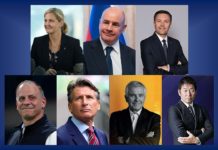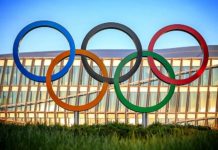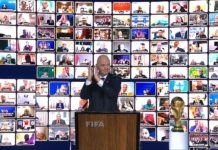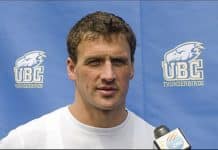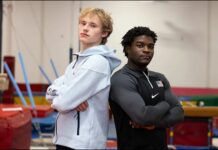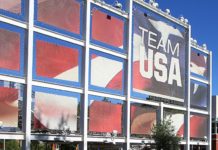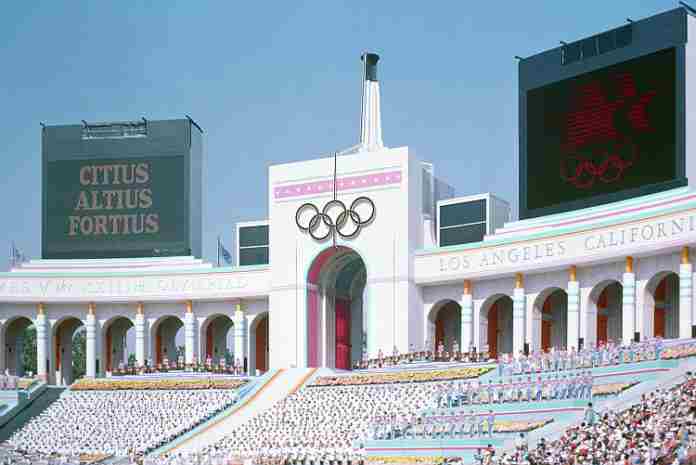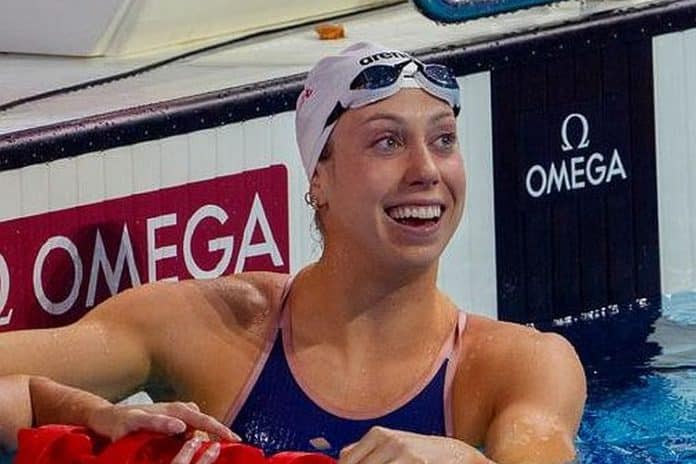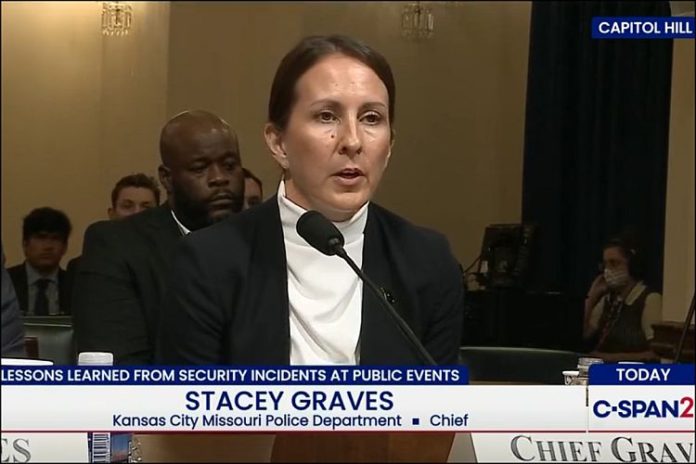★ The Sports Examiner: Chronicling the key competitive, economic and political forces shaping elite sport and the Olympic Movement.★
★ To get the daily Sports Examiner Recap by e-mail: sign up here! ★
≡ LA84: 41 YEARS ON ≡
A third Olympic Games is being organized in Los Angeles, to take place in 2028. Without the success of the 1932 Games, organized with a surplus in the depths of the Great Depression, and the 1984 Games, which re-wrote the script on how major events are assembled, there would be no LA28.
So on the 41st anniversary of the opening of the Games of the XXIIIrd Olympiad, it’s worth looking back for a moment on the Games that changed everything.
That things would be different came from the bid. Los Angeles was the only bidder for the 1984 Games – no, Tehran did NOT bid, only inquired – and the process was a lot simpler than it is now. There was a glossy brochure touting the advantages of Los Angeles and a thick, comb-bound book of responses to questionnaires from the 21 International Federations with sports at the Games.
The introduction, written by Southern California Committee for the Olympic Games chair John Argue, started with five words never seen before in an Olympic bid:
“Arrangements are to be spartan.”
That was a direct response to the C$1 billion deficit from the 1976 Montreal Games, which had scared off everyone else except Los Angeles. And the arduous bid process finally concluded only when a recalcitrant International Olympic Committee agreed that no government entity would agree to be the financial backstop for the Games; the Games would be privately financed.
The rest is history and 41 years ago today, 92,655 people jammed into the Los Angeles Memorial Coliseum to see the four-hour ceremonial opening that captivated a worldwide audience of 2.3 billion. The entry of “rocketman” Bill Suitor, the 84 grand pianos and more was dazzling, but the most stunning moment of the opening came at 5:32 p.m.
One of the impressive features of the Moscow 1980 Olympic opening was the card-stunt section, meticulously rehearsed using thousands of military personnel to portray the Olympic Rings, the Misha mascot and messages of welcome. In Los Angeles, card stunts had been a regular part of college football games – especially UCLA games – for decades and a former UCLA Rally Committee chair, Mark Flaisher, created a program involving everyone in the Coliseum except the press and broadcast sections – 85,000 people – who on cue turned the vinyl cards into the flags of 140 attending nations:
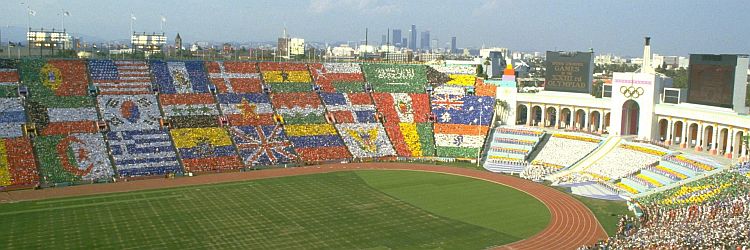 I was in the Coliseum and you could hear the gasps of 92,000-plus people as they understood what they were seeing. The stunt lasted just two minutes, but it stamped the ceremony as one for the ages.
I was in the Coliseum and you could hear the gasps of 92,000-plus people as they understood what they were seeing. The stunt lasted just two minutes, but it stamped the ceremony as one for the ages.
The Los Angeles Games were the third in a row to be boycotted by a group of nations, after Montreal in 1976 and Moscow in 1980. But it also created and extended iconic Olympic figures like Carl Lewis, Joan Benoit Samuelson in the first-ever Olympic women’s marathon, Edwin Moses, Mary Lou Retton, Rowdy Gaines, the U.S. men’s and women’s basketball teams, and many more.
How did it happen?
As the editor of the Official Report of the Games of the XXIIIrd Olympiad, I had the privilege of reviewing the entire history of the Los Angeles Olympic Organizing Committee (LAOOC). To me, five individuals stand out as the catalysts for the success of the Games:
● John Argue, head of the Southern California Committee for the Olympic Games, which served as the private bid committee. Argue, more than anyone else, was the driving force behind the award of the Games to Los Angeles.
● Tom Bradley, Mayor of Los Angeles, who saw the opportunity the Games could offer to the area and skillfully and steadily maneuvered through the political minefields of both the IOC and the Los Angeles City Council, to obtain the Games with no City backing whatsoever. He then managed the City bureaucracy to help make the Games work, in close coordination with the LAOOC.
● Peter Ueberroth, hired to be the President of the LAOOC in March 1979. A 42-year-old travel industry entrepreneur who had built the second-largest agency in the country, Ueberroth led the organizing committee with bravado, insight and a drive to find people equally as committed as he to make the Games work. He was brilliant and rightly celebrated for his and the LAOOC’s achievements.
● Harry Usher, the Executive Vice President and General Manager, who knew Ueberroth from his law practice and took over the day-to-day details of the organizing committee in 1980. It is not an exaggeration to say that the 1984 Games would not have happened without Usher. He was amazing, both in his ability to gather, process and use information, and to get people to work together … whether they wanted to or not.
● David Wolper, the famed television producer and eventually the producer of those memorable opening and closing ceremonies of the Games. But his hidden role was even more important, especially in the early days, helping Ueberroth with the U.S. television negotiations. It was Wolper who developed the concept of looking not at what had been paid for prior Games, but how much revenue a U.S. broadcaster could create from broadcasting the Games; that led to the historic, $225 million deal (plus host broadcaster production responsibility) with ABC in September 1979 that set the LAOOC’s financial foundation.
Only Ueberroth is still with us today; four of the five are pictured below from a party following the 28 July opening: from left to right, Ueberroth, Wolper, Argue and Usher:
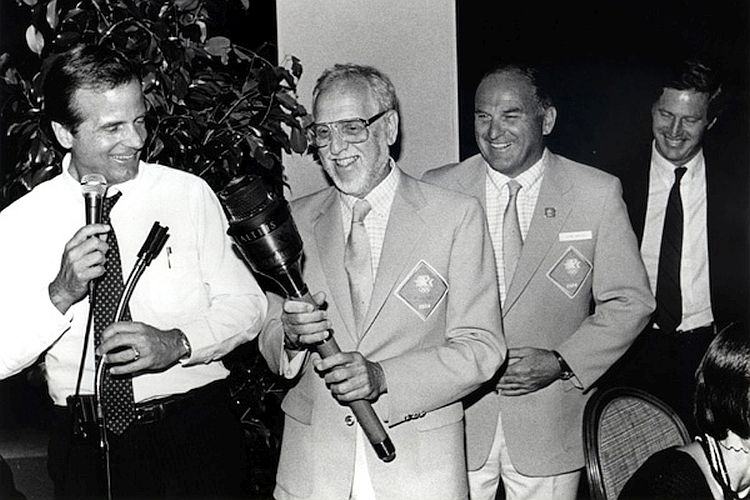
What they and thousands of others achieved was remarkable:
● The Los Angeles Games changed the way television rights are sold, signing a then-staggering $225 million cash rights deal (plus $100 million in host broadcast services) with ABC in 1979, and sports marketing with a program of exclusive categories and limited availability (35 Official Sponsors, 64 Official Suppliers).
● The original budget projections were for $368 million in revenues, $347 million in expenses and a $21 million surplus. But revenues skyrocketed to more than $769 million (209%) and a surplus of $232.5 million was realized, with 60% going to the U.S. Olympic Committee and the National Governing Bodies and 40% to what is now the LA84 Foundation.
● Of the 27 competition venues, only three were built: the McDonald’s Olympic Swim Stadium at the University of Southern California; the 7-11 Eleven Velodrome at Cal State Dominguez Hills and the Olympic Shooting Range in Chino. Everything else was existing or temporary; the USC swimming facility and Chino shooting range are still in operation; the velodrome was removed to create the Dignity Health Sports Park, which includes a new, indoor velodrome.
● Games staffing was founded on the use of volunteers, a concept already part of the Los Angeles culture, but completely new elsewhere. The 1984 Games were staged with a workforce of more than 81,000, with 45,450 from the LAOOC, of which ~33,500 were volunteers. Another 36,000 contract workers were also used, primarily from suppliers and vendors.
● New concepts were introduced in multiple sectors: a 10-week Olympic Arts Festival instead of a Games-period-only program; a four-year youth sports program replaced the Games-period Youth Camp; a national torch relay that raised funds for youth; today’s accreditation system that separates who-you-are from where-you-can-go … all of these were created by the LAOOC. New technologies such as electronic mail and accessed-from-anywhere voice mail were introduced at LA84.
The result was a record-breaking Games on many levels, not least of which was 140 nations in attendance, shattering the Munich 1972 mark of 122. And it proved that the Games need not be a financial loser if existing venues are emphasized, a concept at the center of the International Olympic Committee’s Olympic Agenda 2020, adopted 30 years after the 1984 Los Angeles Games, in 2014.
The legacy of the 1984 Games continues with the LA84 Foundation, opened as the Amateur Athletic Foundation of Los Angeles in 1985 with $93 million of the LAOOC surplus. In the succeeding decades, it has impacted four million young people, invested more than $230 million in youth sports and is tirelessly lobbying for more private and public support for “play equity” for youth.
The 40th anniversary of the 1984 Games was celebrated in considerable style at the LA84 Foundation last year, with Games stars like Lewis, Greg Louganis, Cheryl Miller, Moses, Bart Conner and more on hand.
But even a year later, the 1984 Games is worth remembering, 41 years on.
Rich Perelman
Editor
★ Receive our exclusive, weekday TSX Recap by e-mail by clicking here.
★ Sign up a friend to receive the TSX Recap by clicking here.
★ Please consider a donation here to keep this site going.
For our updated, 699-event International Sports Calendar for 2025, 2026 and beyond, by date and by sport, click here!




